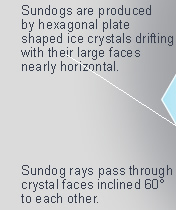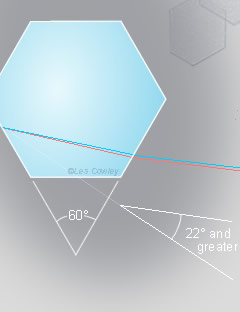
OPOD
What's New
Rays & Shadows
Water Droplets
Rainbows
Ice Halos
Contents
Crystals
Frequent Halos
22° circular
Sundogs
Formation
Sun Altitude
Colours
Moon Dogs
More Images
Tangent Arcs
Circumscribed
Pillars
Circumzenithal
Circumhorizon
Parhelic Circle
Infrequent Halos
Multiple Displays
Other Worlds
Observing Halos
HaloSim
High Atmosphere
Links & Resources
Search - Index
123456789012345678
| Sundog formation |
 |
||||||||
|
| Sundogs,
parhelia, are formed by plate crystals high
in the cirrus clouds that occur world-wide. In cold climates the
plates can also be in ground level as diamond
dust. The plates drift and float gently downwards with their large hexagonal faces almost horizontal. Rays that eventually contribute their glint to a sundog enter a side face and leave through another inclined 60° to the first. The two refractions deviate the ray by 22° or more depending on the ray's initial angle of incidence when it enters the crystal. The condition where the internal ray crossing the crystal is parallel to an adjacent face gives the minimum deviation of about 22°. Red light is refracted less strongly than blue and the inner, sunward, edges of sundogs are therefore red hued. Rays passing through plates crystals in other ways form a variety of halos. When the sun is relatively high, rays cannot pass through the crystal unless they are channeled by being internally reflected from the upper and lower basal (large hexagonal) faces. The skewed angle of incidence also causes the ray deviation to increase and high sun sundogs are farther from the sun. Plate crystals rarely float exactly horizontal, they wobble and the wobble increases with crystal size. Wobbly plates produce tall sundogs and in the more extreme cases the distinction between a tall sundog and fragments of a 22° halo becomes somewhat arbitrary. |





